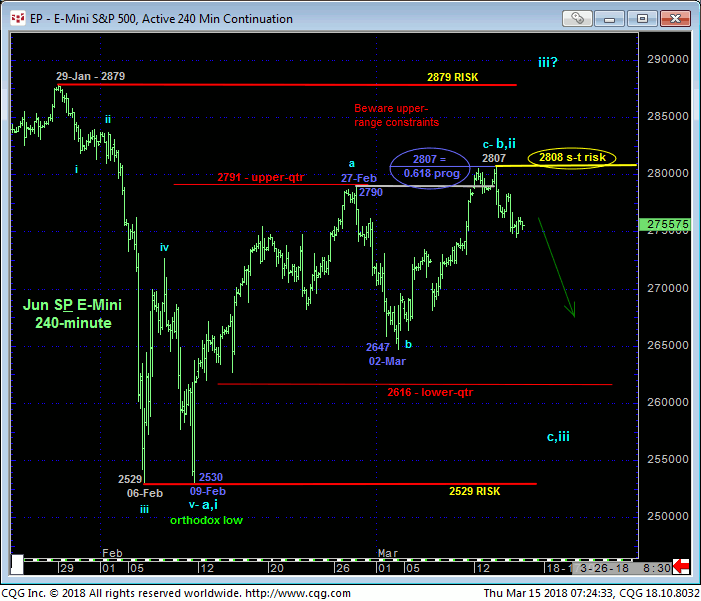
In all of our past month’s blog updates and while 29-Jan’s 2879 all-time high remains intact as a resistant cap, we’ve discussed the prospect that the recovery from 09-Feb’s 2530 low is merely a (b-Wave) correction within a larger-degree correction/consolidation down from that late-Jan high. We’ve highlighted the upper-quarter (above about 2790) of this year’s 2879 – 2530-range as a slippery slope for bulls, and as a result of the past couple days’ relapse we can state with greater confidence and objectivity that Tue’s 2807.25 high is one of developing importance and a new short-term risk parameter from which non-bullish decisions like long-covers and cautious bearish punts can now be objectively based.
Not only has the market failed from the upper-quarter of the range in question, the 240-min chart below shows that the resumed rally from 02-Mar’s 2647 low spanned a length exactly 61.8% (i.e. 0.618 progression) of 09-to-27-Feb’s preceding rally from 2530 to 2790. IF our broader consolidation count is correct, we would expect the market to fall off sharply to the lower-quarter of the range around 2615 or below. A recovery above our new short-term risk parameter at 2808 will not only mitigate this interim bearish/continued-consolidation call, but for market sentiment and long-term trend reasons we’ll discuss below such 2808+ shorter-term strength could re-expose the secular bull to new and potentially huge gains above 29-Jan’s 2879 high.


The daily log scale chart above shows the market’s current position after rejecting the upper-quarter of the past couple months’ range that could have identified Tue’s 2807 high as the end of a b-Wave recovery from 09-Feb’s 2530 low ahead of a (c-Wave) relapse to the lower recesses of the range or below needed to complete the broader correction down from the late-Jan high. Similar technical set-ups are apparent in the energy and metals sectors and seem to reinforce this deferred-bullish count.
From a longer-term perspective however, only a glance at the weekly log chart below is needed to see that UPTREND remains intact as the dominant technical factor for this market, with the recent lateral chop from 29-Jan’s 2879 high easily falling well within the bounds of a mere correction/consolidation within the secular advance. And quite interestingly and supportive of an eventual resumption of the secular bull is the recent erosion in market sentiment levels to those that have warned of and accompanied the ends of corrective dips for about as far back in the bull as you’d like to go.
Indeed, the recent 62%-area lows in the Bullish Consensus (marketvane.net) measure of market sentiment haven’t been seen since Nov’16 while the plunge in the AAII (American Association of Individual Investors; aaii.com) has also returned to historically low levels. These levels do not preclude further lateral-to-lower consolidation. But ultimately we believe they are very reinforcing of our long-term bullish count and the eventual resumption of the secular bull to new highs above 2879. And this resumed bull may be sooner rather than later if the market recovers above 2808 after the past few days’ slip.

Finally, the dominance of the secular bull market remains crystal clear in the monthly log scale chart below where commensurately larger-degree weakness below at least former 2100-area resistance-turned-support remains required to threaten the long-term bull. And again, against this very long-term backdrop it’s interesting to see that even generally later (but volatile) prices since late-Jan have scared the beejeebies out of the retail bulls to historical lows TYPICAL of the ENDS of bull market corrections.
These issues considered, a neutral-to-cautious-bearish policy is OK from 2775 OB with a recovery above 2808 required to not only negate this call and warrant its cover, but also re-expose the secular bull that could take off from there and warrant a cautious bullish bet. In effect, traders are advised to toggle directional biases and exposure around 2808. And until such 2808+ strength is shown, further and possibly sharp losses towards the 2615-area or below should not surprise in the week or two ahead.


